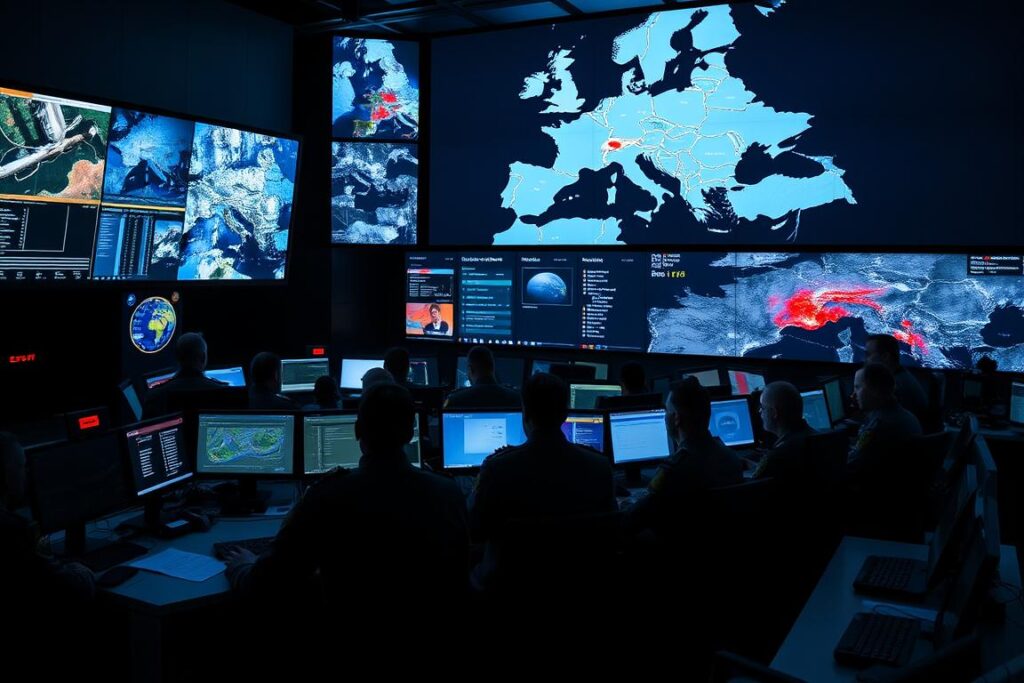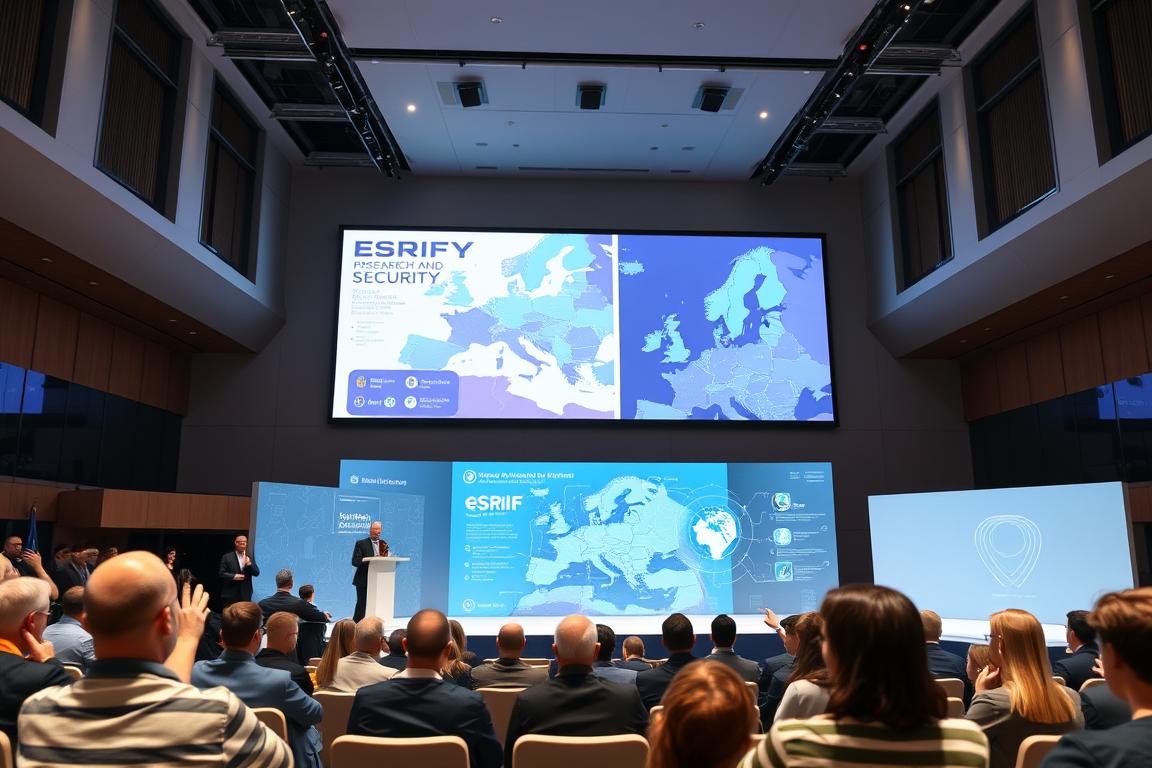European Security Research & Innovation Forum (ESRIF)
Did you know that the European Commission earmarked a staggering €1.4 billion for the European Security Research Programme during the period 2007-2013? This significant investment underscores the importance of security innovation in Europe and the pivotal role the European Security Research & Innovation Forum (ESRIF) plays in shaping the future of European security. Established in 2007 by the European Commission and the EU Member States, ESRIF’s initiatives are central to advancing security research and fostering an inclusive dialogue among industry leaders, research bodies, NGOs, and European administrative entities.
Mid-term results published merely twelve months into ESRIF’s activities highlighted a crucial insight: only legitimate solutions enhance security while respecting fundamental rights and liberties. These findings resonate with the Forum’s overarching aim to consolidate and steer a strategic approach towards security and innovation across the continent.
The European Security Research Conference (SRC), held on 29-30 September 2008, spotlighted the collaborative nature of EU research projects in the security domain. By bringing together a range of public and private stakeholders, the conference deliberated on four critical areas: security of citizens, protection of sensitive infrastructure, crisis management, and border security. Such collaboration is emblematic of how ESRIF sets the agenda for security research as an independent thematic area within the EU’s Seventh Research Framework Programme (FP7).
Key Takeaways
- ESRIF was established in 2007 by the European Commission and EU Member States.
- €1.4 billion was allocated to the European Security Research Programme for 2007-2013.
- Only legitimate solutions that respect fundamental rights can effectively enhance security.
- The European Security Research Conference (SRC) emphasized collaboration across multiple security areas.
- Security research is now an independent thematic area under the EU’s Seventh Framework Programme (FP7).
Introduction to the European Security Research & Innovation Forum
The European Security Research & Innovation Forum (ESRIF) was established in 2007 with a goal to craft a strategic roadmap for security research and innovation in Europe. This introduction to ESRIF highlights its significance in shaping the continent’s security landscape.
History and Establishment
The history of the European Security Research & Innovation Forum dates back to its initiation in 2007. It was conceived to influence the 7th Framework Programme and to set a long-term strategic security research agenda. ESRIF was created to address the market fragmentation in the EU security industry, which in 2008 was valued between €26 billion and €36 billion. The forum aims to bridge gaps in interoperability and create a unified approach to security threats.
Purpose and Goals
The goals of ESRIF are multifaceted, focusing on enhancing the competitiveness of European industries globally and fostering cooperation among stakeholders. The establishment of ESRIF aims to improve dialogue across various sectors, analyze future security needs, and ensure that Europe remains a leader in technological innovation. Emphasizing a „strong and independent technological and scientific base,“ ESRIF seeks to safeguard citizen interests and bolster the quality of products and services. Certification, validation, and standardization of new technologies are among the key focal points to create effective responses to security threats.
The forum also prioritizes the development of a harmonized regulatory framework to counter market fragmentation caused by differing national legislation. By focusing on critical areas such as infrastructure protection, ICT, and space technologies, ESRIF is dedicated to ensuring Europe’s resilience against both man-made and natural threats.
Key Activities of ESRIF
The European Security Research & Innovation Forum (ESRIF) plays a pivotal role in enhancing security measures across Europe through a range of strategic activities. The core focus of ESRIF activities includes vigorous stakeholder engagement and concerted efforts towards fostering innovation in security.
Stakeholder Engagement
ESRIF emphasizes the importance of stakeholder engagement by bringing together diverse sectors such as industry, government, and non-government organizations. This inclusive approach ensures a rich dialogue and collaboration, addressing a wide array of security challenges. This engagement promotes mutual understanding and paves the way for cohesive strategies and solutions in the security domain.
Fostering Innovation
One of the primary aims of ESRIF is fostering innovation in security technologies. By facilitating exchanges between the defense and civilian sectors, ESRIF nurtures the development of groundbreaking ideas and advancements. This not only strengthens the security framework of Europe but also enhances the global competitiveness of European industries, establishing a robust environment for security innovation.
Impact on European Security Policies
The European Security Research & Innovation Forum (ESRIF) has significantly influenced the impact on security policies across the European Union. By actively endorsing a strategic security research agenda, ESRIF has been pivotal in shaping policies that not only address present security challenges but also proactively mitigate future risks. This comprehensive approach ensures that European security technologies and practices remain at the forefront on the global stage.
Strategic Security Research Agenda
One of the key contributions of ESRIF is the establishment of a robust strategic security research agenda. This agenda, supported by significant funding, such as the €1.4 billion budget allocated to the European Security Research Programme (ESRP), focuses on critical areas like surveillance and law enforcement technologies. With 85 projects funded by 2008, amounting to €210 million, and a substantial portion led by defense sector companies, the agenda underpins the alignment of research and development efforts with strategic security goals.
The agenda’s focus extends beyond immediate threats, emphasizing areas like climate change and organized crime, which are increasingly recognized as critical components of national security strategies. ESRIF’s involvement ensures that the security research agenda remains dynamic and responsive to evolving threats.
Global Competitiveness
The global competitiveness of European security has been greatly enhanced through ESRIF’s initiatives. The forum’s comprehensive strategy has not only supported the development of cutting-edge technologies but also promoted a competitive and independent technological base for the European Union. ESRIF’s emphasis on interoperability standards and the integration of civil and defense technologies has advanced the EU’s capabilities in border control, cybersecurity, and critical infrastructure protection.
Additionally, the European Security Research and Innovation Agenda (ESRIA) outlines a detailed roadmap for the next 15 years, ensuring sustained innovation and competitiveness. Significant projects like the TALOS project, which received €20 million for developing an autonomous border protection system, highlight the forum’s dedication to pioneering high-tech solutions that bolster the EU’s security infrastructure.
| Key Metrics | Details |
|---|---|
| ESRP Budget | €1.4 billion |
| Funded Projects by 2008 | 85 projects |
| Investments in High-Tech Border Surveillance Technologies | €50 million |
| Private Security Sector Consultants | 440 out of 660 |
| Funding for TALOS Project | €20 million |
ESRIF’s Role in Crisis Management
The European Security Research & Innovation Forum (ESRIF) plays a pivotal role in enhancing European capacities in crisis management. Established in 2007, ESRIF has been instrumental in developing the European Security Research and Innovation Agenda (ESRIA), focusing on resilience and recovery from both technological and societal perspectives.
ESRIF crisis management efforts focus on ensuring that European nations are well-prepared for emerging security challenges. By fostering a strategic and coordinated approach to crisis preparedness and response, ESRIF effectively aids in managing security crises in Europe. The forum’s emphasis on a harmonized regulatory framework and interoperability standards facilitates efficient information sharing among national authorities and European actors.
| ESRIA Clusters for R&D Support |
|---|
| Classic security cycle: preventing, protecting, preparing, responding, and recovering |
| Countering different means of attack |
| Securing critical assets/infrastructures |
| Securing identity, access, and movement of people and goods |
| Cross-cutting enablers, particularly Information and Communication Technologies (ICT) |
Acknowledging that risks to European security cannot be precisely predicted, ESRIF encourages the inclusion of civil protection, conflict prevention, and post-crisis management in future security R&D programs. By adopting a „Privacy by Design“ approach, ESRIF ensures privacy protection is integrated from the earliest stages of security solution development, which is critical for managing security crises in Europe.

The budget allocations under the FP7 and other specific programs emphasize the significance EU places on robust crisis management capabilities. With an estimated total market value of €26 to €36 billion in 2008, the security industry needs a strong and independent technological and scientific foundation to safeguard citizens‘ interests effectively.
ESRIF’s unwavering commitment to crisis management, including fostering initiatives under the Lead Market Initiative (LMI), positions the EU as a leader in the global security market. The need for a harmonized regulatory framework and the development of interoperability standards are vital for enhancing the competitiveness and efficiency of Europe’s security industry, ensuring the EU is well-equipped to handle potential security crises.
Collaborations and Partnerships
The European Security Research and Innovation Forum (ESRIF) has established a cornerstone in fostering ESRIF collaborations across various sectors. These partnerships are pivotal for advancing security research and implementing innovative solutions that enhance both national and international security frameworks.
Industry and Academia
One of the most significant aspects of ESRIF collaborations is the industry-academia collaboration. By bridging the gap between these two sectors, ESRIF promotes robust exchanges of knowledge, driving innovation and practical applications of research findings. Since 2007, the German Federal Ministry of Education and Research (BMBF) has allocated over 250 million euros for the national framework program for civil security, showing a substantial commitment to such initiatives. Furthermore, the BMBF’s „Research for Civil Security“ framework, adopted in January 2012 with a budget of 222 million euros, underscores the critical role of securing cyberspace, economic stability, and citizen safety through collaborative efforts.
Government and NGOs
Government and non-governmental organizations (NGOs) play a crucial role in ESRIF collaborations. By partnering with research organizations, government bodies, and private sector stakeholders, these collaborations ensure a comprehensive approach to security challenges. The German security research program, part of the federal government’s „High-tech Strategy for Germany,“ prioritizes security alongside other major sectors such as climate, energy, health, and mobility. This inclusive approach has led to enhanced security and resilience across society through high-tech solutions and organizational strategies. The shift from a state-centric to a more holistic approach reflects the evolving nature of security needs, integrating societal and individual perspectives into national agendas.
Overall, ESRIF’s partnerships in security research are instrumental in addressing a wide array of risks. These collaborations not only foster innovation but also ensure that security strategies are proactive and comprehensive, keeping pace with the changing landscape of global threats.
The European Security Research and Innovation Agenda (ESRIA)
The European Security Research and Innovation Agenda, commonly known as ESRIA, represents a forward-looking plan architected by the European Security Research and Innovation Forum (ESRIF). Set to guide European security research and innovation for the next 20 years, ESRIA aims to holistically anticipate and address emerging challenges within the security sector. This comprehensive agenda serves as a blueprint for integrating cutting-edge technologies, fostering collaboration, and ensuring that Europe remains at the forefront of global security advancements.
Since its inception, major investments underscore the emphasis placed on security research in the region. For instance, the German Federal Ministry of Education and Research (BMBF) has allocated over 250 million euros from 2007 for the security of citizens through the first national framework programme for civil security. Subsequently, in January 2012, the BMBF introduced a new framework programme, „Research for Civil Security,“ with a budget of approximately 222 million euros, reflecting a continued commitment to societal resilience and safety.
ESRIA meticulously projects the technological needs and strategic focus for the upcoming decades. Reflecting on the „High-tech Strategy for Germany,“ security emerges as an essential priority alongside climate/energy, health/nutrition, mobility, and communication. Enhanced resilience through innovative high-tech solutions and organizational strategies becomes the cornerstone of future developments. The strategic alignment within this agenda illustrates the commitment to a multi-faceted and dynamic understanding of security, encompassing cultural, architectural, organizational, and technological dimensions.
The European Union has mirrored this emphasis with substantial investments. Since 2004, approximately 3.5 billion Euros have been allocated towards security research, promoting a robust security architecture across member states. Programs like the 7th Research Framework Programme (FP7) and collaborative projects demonstrate a concerted effort to address societal needs while leveraging technological advancements.
Key shifts in understanding security—from solely countering state-centric threats to embracing a broad spectrum encompassing economic, ecological, humanitarian, and health perspectives—underscore ESRIA’s holistic approach. This broader vision reflects how security intertwines with domestic and foreign policy, including defense, economic, environmental, and human rights considerations. The transition from an exclusive focus on threat elimination to risk management and uncertainty mitigation reveals a nuanced and evolved security paradigm pivotal for future planning.
The effective dissemination and adaptation of ESRIA’s principles depend significantly on fostering interdisciplinary collaborations. The BMBF’s emphasis on partnering with research institutions, government agencies, and private sector stakeholders encapsulates the agenda’s inclusive approach. The spotlight on small and medium-sized enterprises (SMEs) as key suppliers of security technologies further underscores the agenda’s commitment to innovation and sustainability.
In summary, ESRIA’s ambitions translate into a robust framework poised to navigate and conquer security challenges through strategic foresight, technological innovation, and collaborative endeavor. Through this, the European Security Research and Innovation Agenda ensures that Europe remains a beacon of safety, technological prowess, and proactive resilience.
ESRIF Conferences and Events
ESRIF conferences and events play a pivotal role in advancing European security research. These security research events in Europe provide platforms for stakeholders to come together and share insights, discuss innovations, and explore the dynamic security landscape. They serve as essential touchpoints for maintaining ongoing engagement and ensuring the collective ability to respond to emerging threats.
Annual Meetings
The annual meetings on security are highly anticipated events within the European security community. These gatherings offer a comprehensive overview of the latest advances in security research and strategic policy updates. By convening experts from industry, academia, and government, these annual ESRIF conferences foster collaboration and align efforts towards common goals. Stakeholders can engage in meaningful dialogue, share best practices, and forge new partnerships, ensuring a unified approach to addressing security challenges.
Workshops and Seminars
In addition to the annual meetings, ESRIF organizes a series of workshops and seminars throughout the year. These specialized sessions delve into specific areas of interest, such as cybersecurity, crisis management, and the protection of critical infrastructure. The workshops provide an interactive environment where participants can engage in detailed discussions, hands-on activities, and knowledge exchange. By continually hosting these focused security research events in Europe, ESRIF ensures that all stakeholders remain informed of cutting-edge developments and emerging threats.
Challenges and Opportunities
The European Security Research & Innovation Forum (ESRIF) stands at a pivotal junction where it faces both significant challenges in European security and a myriad of opportunities in security innovation.
One of the primary challenges is adapting to the ever-evolving landscape of security threats. With the complexity of cyber-attacks, terrorism, and other criminal activities increasing, ESRIF must continually reassess and enhance its strategic approaches.
Another challenge is the coordination among diverse stakeholders, including national governments, law enforcement agencies, academic institutions, and private sector entities. Ensuring cohesive and effective cooperation remains a difficult task. For instance, the early meetings of ENLETS evidenced limited engagement, as highlighted by the absence of major EU nations like the UK, Spain, and Italy at the second ENLETS meeting in Prague in 2009.
Additionally, logistical issues such as funding for travel costs and the lack of translation services at ENLETS meetings pose considerable barriers to broader participation. The Hungarian Presidency, for instance, had to extend the deadline for replies to their ENLETS questionnaire due to limited feedback, underscoring the ongoing difficulties in garnering comprehensive support and engagement.
Despite these challenges, ESRIF has numerous opportunities in security innovation. By leveraging advancements in cybersecurity technologies, ESRIF can lead the charge in creating more robust defenses against contemporary threats. The ESRAB, with approximately 70 members supported by over 300 experts, exemplifies the depth of expertise available to drive these advancements.
The collective European response to security challenges can be significantly enhanced through initiatives like the European Security Research and Innovation Agenda (ESRIA). Projects such as the Security Technology Active Watch (STRAW) and the Coordination action on Risks, Evolution of threatS and Context assessment (CRESCENDO) project have already set precedents by integrating diverse expert inputs into actionable R&D roadmaps.
Additionally, the long-term vision for ENLETS to become a „formally structured collaboration“ aligns with the broader goals of standardization and interoperability. This approach reflects a shift towards a more integrated framework in European security research, bridging the gap between law enforcement needs and technology providers.
| Aspect | Challenges | Opportunities |
|---|---|---|
| Stakeholder Engagement | Limited feedback, varied participation | High potential for cohesive cooperation |
| Technology | Adapting to emerging threats | Leading advancements in cybersecurity |
| Funding and Logistics | Travel cost issues, lack of translations | Streamlining resources across the EU |
| Strategic Vision | Implementing cohesive strategies | Creating integrative and interoperable frameworks |
Future of ESRIF and European Security Research
The future of ESRIF looks promising as it continues to play a crucial role in shaping European security research advancements. Established in 2007, ESRIF has successfully developed the European Security Research and Innovation Agenda (ESRIA), which outlines a strategic roadmap for security R&D over the next 15 years. This agenda is designed to improve coherence at EU, national, and regional levels, addressing the challenges of market fragmentation and enhancing the competitiveness of the EU security industry.
A significant aspect of ESRIF’s future endeavors involves fostering innovations and strategic collaborations. By engaging with stakeholders from industry, academia, government, and NGOs, ESRIF aims to create a more integrated and efficient security market. The Lead Market Initiative (LMI) proposed by ESRIA seeks to position the EU as a leader in the global security market, focusing on areas such as countering various means of attack, securing critical infrastructures, and enhancing cross-cutting enablers like Information and Communication Technologies (ICT).
Looking ahead, ESRIF emphasizes the importance of a strong and independent technological and scientific base to safeguard citizens‘ interests and ensure competitive industry offerings. The Commission underscores the need for research on critical infrastructure protection, with particular attention to energy security and transport network security. As the relationship between civil and defense technologies evolves, strengthened cooperation in areas like border control and cybersecurity becomes imperative. The future of ESRIF and European security research will undoubtedly be pivotal in navigating the complex landscape of global security, ensuring Europe remains at the forefront of technological advancements and effective security measures.






